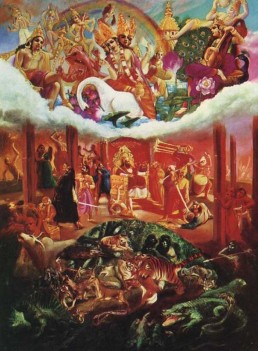
गुणत्रयविभागयोग
Guṇa-Traya-Vibhāga-Yoga - The Yoga of the Threefold Modalities
If the entire observed universe is nothing but the One Self expressing through the world of matter, how do we explain the endless variety of forms and experiences, each distinct from the other? This chapter answers that question by introducing the concept of the threefold “guna” which conditions all matter. Having explained how this works, the Lord points out that our goal is to transcend beyond these gunas and recover our true, immortal nature. Below are the main themes of Chapter 14:
Verses 1 - 4
Introduction
Verses 5 - 18
Analysis of guṇas
Verses 19 - 20
Knowledge as the means to transcend the guṇas
Verses 21 - 27
Guṇatīta-lakṣaṇam and sādhanam
Gita Chapter 14 - 27 Verses
Chapter 14 - 27 Verses
Commentary by Swami Paramarthananda
Background
[In the 13th chapter, Lord Kṛṣṇa said that it is the association with the guṇas of prakṛti that is responsible for rebirth i.e. saṃsāra (XIII-22). In this chapter, the Lord deals with this topic elaborately and shows how one can be free from these binding guṇas.]
In the first two verses Kṛṣṇa praises Self-knowledge to draw Ar-juna’s attention. It is the greatest knowledge which takes one to the greatest goal of liberation. By this knowledge, one attains the nature of God Himself and thus becomes free from birth and death.
In the next two verses, Kṛṣṇa gives a brief account of creation. Blessed by the Lord (puruṣa), prakṛti gives birth to this universe. Thus, they are the universal parents from whom all things and beings origi-nate.
From the 5th to the 18th verse, Bhagavān makes an elaborate analysis of the three guṇas — sattva, rajas and tamas. They are born of prakṛti and are responsible for the human bondage. The Lord analyses them from various angles which can be depicted in the form of a chart.
Even though all the beings have the three guṇas, they differ be-cause of the predominance of one guṇa over the other two. (It is also possible to change the proportions for which alone all the preparatory sādhanās are prescribed) (10).
In the 19th and 20th verses, Kṛṣṇa teaches the means of tran-scending the guṇas. The Lord points out that the transcendence is in the form of knowledge alone. The Self (puruṣa) happens to be already beyond the guṇas (guṇātīta). It is the body (prakṛti) which has guṇas, doership, etc. Because of identification with the body alone, the Self (puruṣa) seems to have guṇas. Hence the only solution is to discrim-inate and own up the guṇātīta puruṣa as oneself (19). Through this knowledge, one discovers oneself to be free from birth, death, etc. This is liberation (20).
Arjuna asks Kṛṣṇa about the characteristics of a guṇātīta and the sādhanā to achieve this (21).
From the 22nd to the 25th verse, Kṛṣṇa answers the first ques-tion. Guṇatīta is one who is detached from prakṛti. He does not have I-notion in his body or my-notion in the world. Hence, he looks at the variations of guṇas objectively without reacting to them (22). He re-mains unaffected by the opposite experiences of life like pleasure-pain, praise-censure, honour-dishonour, etc. They are the play of prakṛti (23, 24). Being full, he does not seek anything and therefore is free from selfish activities (25). (Since a guṇātīta is invariably a wise man, this description tallies with the sthitaprajña portion of the 2nd chapter as well as the parābhakta portion of the 12th chapter).
Kṛṣṇa concludes by prescribing bhakti as the sādhanā to achieve this goal. (Thus, the Lord answers Arjuna’s second question. By the grace of the Lord one gets a guru. Through the guru, one gets the knowledge which makes one guṇātīta). A bhakta becomes fit to attain Brahman’s nature (guṇātītatvam) which is immortality and absolute ānanda (26, 27).
| No. | Topic | Sattva | Rajas | Tamas | |||||||
| 1 | Lakṣaṇam | Prakāśātmakam | Rāgātmakam | Mohanātamakam | |||||||
| (Definition) | (Of the nature of bright- | (Of the nature of delu- | (Of the nature of attach- | ||||||||
| ness) | (6) | sion) | (7) | ment) | (8) | ||||||
| 2 | Bandhanaprakāra | Jñānasaṅga | Karmasaṅga | Pramādasaṅga | |||||||
| (Mode of | bind- | (By causing attachment | (By causing attachment | (By causing attachment | |||||||
| ing) | to knowledge) | (6, 9) | to activity) | (7, 9) | to indifference) | (8, 9) | |||||
| 40 | 3 | Liṅgam | Jñānavṛddhi | Karmavṛddhi | Pramādavṛddhi | ||||||
| (Sign of predomi- | (Increase of | knowl- | (Increase of activity) | (Increase | of | indiffer- | |||||
| nance) | edge) | (11) | (12) | ence) | (13) | ||||||
| 4 | Gati | Ūrdhvagati | Madhyamagati | Adhogati | |||||||
| (Travel | after | (To higher lokas) | (To middle lokas) | (To lower lokas) | |||||||
| death) | (14, 18) | (15, 18) | (16, 18) | ||||||||
| 5 | Phalam | Puṇya & Jñānam | Duḥkham & Lobha | Ajñānam & Moha | |||||||
| (Consequence in | (Puṇya and knowl- | (Sorrow and greed) | (Ignorance | and delu- | |||||||
| this life) | edge) | (16, 17) | (16, 17) | sion) | (16, 17) | ||||||
The topics discussed in this chapter are:
- Introduction: 1 to 4
- Analysis of guṇas: 5 to 18
- Knowledge as the means to transcend the guṇas: 19 to 20
- Guṇatīta-lakṣaṇam and sādhanam: 21 to 27
Since the main topic here is the discrimination of the three guṇas and the Self (puruṣa), this chapter is called Guṇatraya-vibhāga-yoga.

